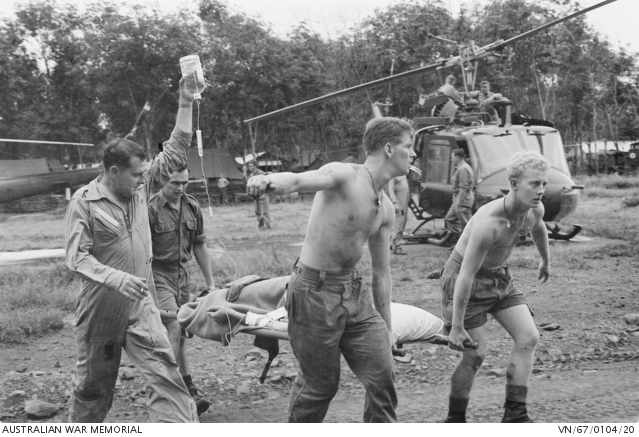Cold War nurses
What influenced me to go was the thought of caring for young people that were prepared to go … prepared to do something about communism.Lieutenant Peg Webster
The Cold War dominated international affairs for 30 years after the Second World War. Australian troops were committed to campaigns in Korea, Malaya, Indonesia, and Vietnam. As in earlier wars, nurses had to adapt rapidly to new environments and heavy workloads, often despite limited preparation and clinical inexperience.
Australian army nurses based at the British Commonwealth General Hospital in Japan visit the ruins of Hiroshima in 1955
Most women’s services were reduced or disbanded after the Second World War, but AANS nurses continued to serve overseas. From 1946 to 1956, some 140 were posted to Japan to care for Australian servicemen and their families as part of the British Commonwealth Occupation Force (BCOF) and later British Commonwealth Forces Korea. The AANS was granted the title “Royal” in 1948, and three years later became an army corps with the new title “Royal Australian Army Nursing Corps” (RAANC). A peacetime RAAFNS was reinstated in 1948 and its members were largely involved in aero-medical evacuations; it was integrated into the RAAF Medical Branch in 1977.
In a move that reflected the changing status of women in the Australian workforce, in the 1970s female nursing officers were finally given the same status and pay as their male equivalents. They could now also continue to serve after they married and had children. The first male nursing officers entered the services around this time.
We often visited the very sick Japanese in Hiroshima and surrounds, taking food, clothing … and giving them what little comfort we could.
Captain Barbara Probyn-Smith
RAAF nurse Sister Julie McCormack prepares for her first flight in a two seater Meteor trainer in South Korea, 1953. Photographer unknown Kimpo, Korea, 1953. JK0886
Vietnam: in the air and on the ground
You were sending home week after week, planes full of young, mutilated people. Most people see amputated limbs as nice rounded finished off stumps. We didn’t get that. We had the ragged ends.
Lieutenant Fay Lewis
Australian soldiers lie strapped to their stretchers inside a RAAF Hercules aircraft, while two RAAF nurses check on them prior to take-off from Vung Tau.VN/66/0120/15
Army, RAAF, and civilian nurses played a key role in the Vietnam War. Between 1967 and 1971, 150 military and 200 volunteer civilian nurses served in South Vietnam. Their tour of duty ranged from three to 13 months, but most stayed about a year.
Advances in medical technology and methods of patient care saved many lives. “Dust-off” helicopters lifted the wounded from the battlefield, and often within an hour the men were in hospital. This radically slashed battle casualty mortality rates, but meant the nurses had to deal with more and more patients.
Many of the injuries were “traumatic amputations” caused by mine explosions, but gunshot and shrapnel wounds remained a common form of battle casualty.
The work was very demanding, and the hours long. Intensive care nurses undertook at least six 12-hour shifts a week. During the 1968 Tet Offensive some toiled for 14 nights straight. Most had been given little preparation for what they would encounter when they arrived, and some initially got a hostile reception from male medical staff. When they returned to Australia, they had to contend with public anti-war sentiment.
First group of Australian Army nurses to arrive in Vietnam, in May 1967. For the next four years, 43 RAANC nurses served in Vung Tau, in groups of six to ten. Photographer unknown - Vietnam, 1967 - digital print, 2011.P00582.045
Lieutenant Catherine Matthews treats a local child. Whenever they could, Australian nurses gave medical assistance to the South Vietnamese people.EKN/68/0116/VN
Known as “Fort Petticoat”, the nurses’ accommodation at 8th Field Ambulance was built on sand dunes close to the beaches of the South China Sea. In the steamy tropical climate, the surf provided welcome relief for off-duty nurses.P02017.022
The uniform was totally inappropriate … too hot and difficult to maintain, due to lack of starch and the wet. Still wearing veils!!??
Lieutenant Ann Hall
Captain Barbara Black (left) in traditional army nursing grey ward dress and starched veil with Lieutenant Diane Carlson (right) in US Army nurses' fatigues.P04690.001
A wounded soldier is unloaded from an RAAF Iroquois helicopter which has winched him out of the jungle.VN/67/0104/20
When battle casualties occurred … we would receive a radio message warning us of incoming casualties. The hospital was brought to ALERT by a shrill blast of a siren, which stopped the routine activities of the unit in its tracks. Staff quickly assembled to receive casualties.
Captain June Naughton
Medevac nurse: Flight Officer Patricia Furbank
Flight nursing had its own particular dangers and stresses … medevac aircraft took constant pounding and landings at times were bone jarring.
Unlike the army nurses, air force nurses were not posted to Vietnam itself, but to the RAAF base at Butterworth in Malaya. Pat Furbank was one of 106 nursing officers who served on aero-medical evacuations between Vietnam, Malaya, and Australia during the course of the war. These evacuations played a crucial role in increasing battlefield casualty survival. During the Second World War, 8.5 per cent of casualties died after reaching hospital. In Vietnam the figure was less than 3 per cent.
In 1970 Furbank was attached to the US Air Force Aero Medical Evacuation Squadron (AMES), based at the Clark Air Base in the Philippines. Thirty-two RAAFNS sisters served with the AMES between 1966 and 1971. These 60-day assignments gave the nurses large-scale, medevac war experience.
On an American Hercules, stretchers could be placed five deep, allowing up to 74 patients to be carried per flight, along with two flight nurses and up to three medical technicians.










